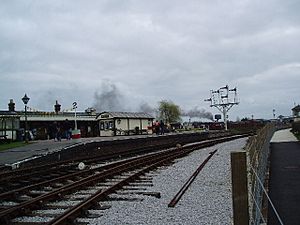Buckinghamshire Railway Centre facts for kids
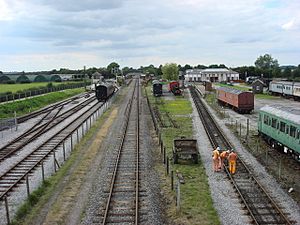
View along the main line towards Quainton Road, showing the two sides of the centre, taken from the footbridge. Main buildings, from left-right: Ministry of Food Buffer Depot; Brill Tramway platform; Quainton Road; the former building of Oxford Rewley Road
|
|
| Established | 1969 |
|---|---|
| Type | Operational railway museum |
| Key holdings | Metropolitan Railway E Class No.1 GWR 4073 Class No.5080 Defiant GWR 6959 Class No.6989 Wightwick Hall South African Class 25NC 4-8-4 No.3405 |
| Owner | Quainton Railway Society (Some land leased from Network Rail) |
| Public transit access | Quainton Road or Aylesbury |
The Buckinghamshire Railway Centre is a cool place where you can explore old trains and learn about railway history. It's a museum run by the Quainton Railway Society Ltd. You can find it near Quainton Road railway station, about 5 miles west of Aylesbury in Buckinghamshire, England.
The centre is split into two parts. Two footbridges connect these parts, and one of them is even wheelchair friendly. Each side has a special track where trains can run. There are also workshop buildings and museum displays to explore.
Contents
History of the Railway Centre
In 1962, a group called the London Railway Preservation Society started. They collected old London Underground vehicles and other railway items. They also gathered the largest collection of things from the London and North Western Railway.
These items were kept in different places around London. It was hard to get to them, fix them up, and keep them safe. So, in 1969, the Quainton Railway Society was created. Their goal was to open a working railway museum at Quainton Road station.
On April 24, 1971, the two societies joined together. The Quainton Railway Society then took care of all the historic railway equipment.
Bringing the Station Back to Life
The station building was kept in good shape. It was used as a bookshop and a place to buy tickets. The many railway tracks, called sidings, were still there. Even though they were disconnected from the main railway line in 1967, they were used to fix up old trains.
The Society worked hard to make the main station building look like it did in 1900. They then renamed the whole place the Buckinghamshire Railway Centre. A smaller building, which used to be a waiting shelter, now shows the history of the Brill Tramway. An old building from Wembley Park was even moved and rebuilt at Quainton Road. It now serves as a workshop for fixing trains.
Main Railway Line Services

Even though the museum's trains run on old sidings, a busy Network Rail line still goes through the station. This line connects Aylesbury to the route between Bletchley and Oxford.
Large freight trains often use this line. They carry things like landfill waste and materials for the High Speed 2 railway project. These trains travel from London and other parts of England.
From 1984 to 1990, special Christmas shopping trains stopped at Quainton Road. Also, from 1971 to 1987, and again from 2001 to 2017, special passenger trains ran from Aylesbury for events at the Centre. These shuttle trains were popular during holiday weekends.
The Centre Today
The Buckinghamshire Railway Centre has grown a lot. It now has about 170 different locomotives (train engines) and railway cars. These are kept in buildings that date from 1874 to the 1960s.
Old warehouses from World War II are now used to display many items waiting to be fixed. The Society also has a library for its members.
Rewley Road Station Building
Rewley Road was a station in Oxford that closed to passengers in 1951. In 1999, the main building of Rewley Road station was carefully taken apart.
Then, in 2002, it was rebuilt at the Buckinghamshire Railway Centre. This new building now offers better facilities for visitors. It also houses the main offices of the Quainton Railway Society.
Filming Location
Quainton Road station is very well-preserved. Because of this, it's often used as a place to film TV shows and movies. Some of the shows filmed here include The Jewel in the Crown, Doctor Who (the episode Black Orchid), Midsomer Murders, and Taskmaster.
Future Plans
The new High Speed 2 railway line is planned to pass just west of the centre. This won't directly affect the museum. However, it means that the old Brill Tramway line cannot be rebuilt in the future.
Collection of Trains
The Buckinghamshire Railway Centre has a large collection. It includes many different types of locomotives, carriages, and other railway vehicles. There are also lots of railway items and documents.
Locomotives (Train Engines)
Here are some of the interesting locomotives you can see:
| Class | Number (and name) | Status | Notes | Image |
|---|---|---|---|---|
| Metropolitan Railway E Class | No.1 (London Transport L44) | Under overhaul | Built in 1898. Needs boiler repairs. | 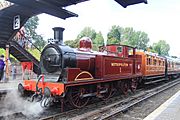 |
| LSWR 0298 Class | 314 (British Railways 30585) | Static Display | Built in 1874. Its boiler certificate expired in 2016. |  |
| Peckett and Sons | No.1159 Annie | Under overhaul | Built in 1908. Arrived in 2018. It's currently being fixed up. | |
| Peckett and Sons | No.2105 Rokeby | Static Display | Built in 1951. Often used for goods trains or vintage trains. |  |
| North British Locomotive Company | Coventry No.1 | Static Display | Built in 1939. Used to be dressed up as Thomas the Tank Engine. Now on display. | 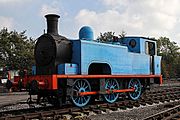 |
| Hudswell Clarke | No.1742 Millom | Operational | Built in 1946. Used for goods and vintage trains. Currently looks like Percy the Small Engine. |  |
| Aveling and Porter | No.3587 Sydenham | Under overhaul | Built in 1895. |  |
| GWR 6959 Class | 6984 Owsden Hall | Under restoration | Built in 1948. Its tender (the part that carries coal and water) is being used by another engine, 6989. |  |
| GWR 6959 Class | 6989 Wightwick Hall | Operational | Built in 1948. It was fully restored in 2018. It's currently on loan to the Bluebell Railway. |  |
| GWR 7200 Class | 7200 | Under restoration | Built in 1934. | 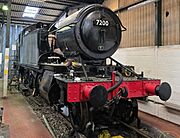 |
| Hunslet Austerity 0-6-0ST | No.3890 NCB 66 | Operational | This was the last Hunslet Austerity engine built in 1964. |  |
| Peckett and Sons | No.1900 | Under overhaul | Built in 1936. This is Britain's smallest standard-gauge steam locomotive! | 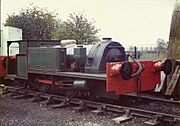 |
| Andrew Barclay | No.699 Swanscombe | Under overhaul | Built in 1891. This is the oldest surviving Barclay engine. | 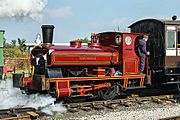 |
| Bagnall | No.2469 Scott | Static display | Built in 1932. Its boiler certificate expired in 2024. | 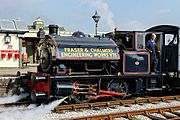 |
| Andrew Barclay | No.2243 | Static display | Built in 1948. This is a "fireless" locomotive, meaning it doesn't burn fuel. | 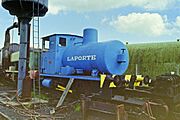 |
| Aveling and Porter | No.807 Brill | Static display | Built in 1872. This was the first engine for the Brill Tramway. | 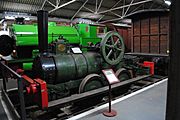 |
| GWR 5700 Class | 7715 (London Transport L99) | Static display | Built in 1930. It has been out of service since 2011 due to a cracked boiler. |  |
| Hawthorn Leslie | No.3718 Swanscombe No.4 | Operational | Built in 1928. It started running again in 2018. It's currently at the Northampton and Lamport Railway. | |
| Hunslet | No.3782 Arthur | Operational | Built in 1953. It returned to service in 2024. It's currently dressed up as Thomas the Tank Engine. | 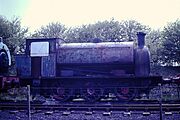 |
| LNWR | 3020 Cornwall | Static Display | Built in 1847. This very old engine is on loan from the National Railway Museum. | 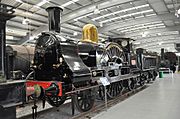 |
| South African Class 25NC | 3405 | Static Display | Built in 1953. This is a large engine from South Africa. |  |
| Sentinel Waggon Works | No.6515 Isebrook | Operational | Built in 1945. It returned to steam in 2019. It's currently at the Cholsey and Wallingford Railway. | 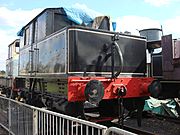 |
| Sentinel Waggon Works | No.9366 Cynthia | Operational | Built in 1945. It returned to steam in 2017 after a big repair. | 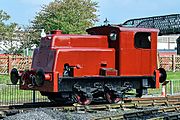 |
| British Rail Class 04 | D2298 | Under Restoration | Built in 1960. It's being fixed after its engine broke down. | 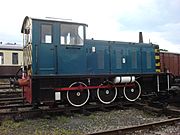 |
| John Fowler | No.20067 Osram | Static Display | 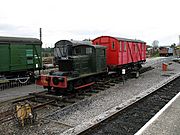 |
|
| F.C. Hibberd "Planet" | No.2102 | Static Display |  |
|
| F.C. Hibberd | No.3271 Walrus | Static Display | 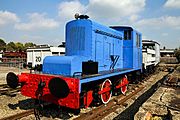 |
|
| Hunslet | K4428 Redland | Static Display | 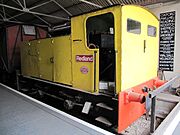 |
|
| Ruston & Hornsby | No.463153 Hilsea | Operational | This engine used to belong to British Gas. | 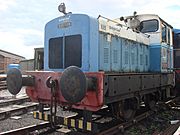 |
Other Trains and Carriages
The centre also has:
- A Class 115 unit, which is a type of train that can run on its own.
- A Post Office Railway (London) train car from 1930.
- A London Underground train unit.
- A New York City Subway car, which has been turned into a cafeteria for visitors!
Carriages and Vans
You can also see many different types of railway carriages and vans at the centre.
Passenger Carriages
These are the carriages that carried people:
| Original company | Number | Type | Status/Notes | Image |
|---|---|---|---|---|
| WCJS | 102 | Sleeper, then inspection saloon | This carriage was rebuilt in 1903. Only the body of the carriage remains. | 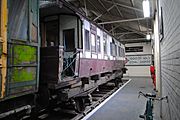 |
| LNWR | 112 | First class sleeper, then cinema coach | Built in 1907. It was used as a cinema coach until 1972. It now shows the story of the Quainton Railway Society. | 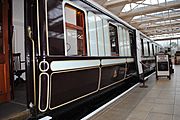 |
| LNWR | 182 | Picnic saloon | Built in 1894. It has been restored and is ready to be used. |  |
| LNWR | 249 | First class diner | Built in 1901. This carriage was used by staff on the royal train from 1905 to 1967! It has been restored. |  |
| GNR | 459 | Third class | Built in 1900. It is currently being restored. | 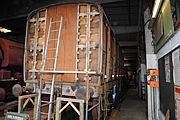 |
| Great Central Railway | 652 | Suburban Brake Third | Built in 1916. Its restoration started while it was on display. | 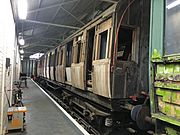 |
| MSJAR | 1076 | Third class | Built in 1890. It has been restored and is ready to be used. | 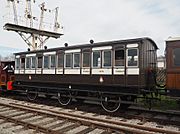 |
| GNR | 1470 | Brake third | Built in 1889. It is ready to be used and is painted in GNR colours. |  |
| GWR | 2242 | Hawksworth Brake Corridor Third | Built in 1950. It is used for volunteers to stay overnight. | 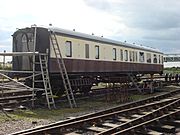 |
| BR | 5324 | Mk2 Tourist Second Open | Built in 1968. It is now used as a sales coach for the 6989 Wightwick Hall engine. | 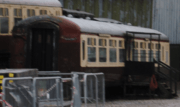 |
| GWR | 9001 | 12-Wheel Collett Special Saloon | Built in 1940. This carriage was used by important people like Winston Churchill and Dwight Eisenhower during World War II! | 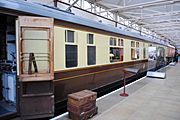 |
| BR | 16235 | Mk1 Corridor Composite | Built in 1963. It is ready to be used. | |
| LNER | 22219 | Suburban Third | Built in 1926. This is the only one of its kind left. | 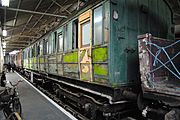 |
| BR | 24993 | Mk1 Corridor Second | Built in 1956. It is ready to be used and has been repainted. | 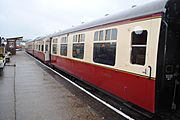 |
| BR | 25500 | Mk1 Corridor Second | Built in 1958. One part of the coach is currently held up because a wheel set is missing. | |
| BR | 35192 | Mk1 Brake Corridor Second | Built in 1958. It is ready to be used and is painted in BR Crimson and Cream colours. |  |
| BR | 53190 | Mk1 Suburban brake second | Built in 1954. It is ready to be used. | 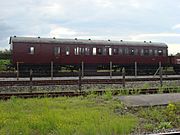 |
Non-Passenger Carriages
These are carriages that carried goods or were used for other purposes:
| Original company | Number | Type | Status/Notes | Image |
|---|---|---|---|---|
| SR | 1108 | 4-wheel PMV (Parcels and Miscellaneous Van) | Built in 1936. It recently got a new paint job. | 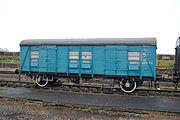 |
| LSWR | 5025 | 4-Wheel Luggage Van | Built in 1917. It has been restored and is ready to be used. | 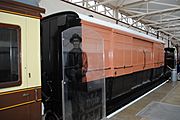 |
| LNWR | 11388 | 6-wheel Covered Carriage Truck | Built in 1911. This is one of only two left of its kind. | 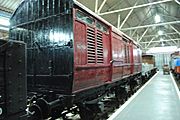 |
| BR | 86450 | General Utility Van | Built in 1954. It was used for displays and storage. | 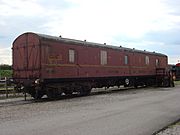 |
| BR | 94578 | 4-wheel Covered Carriage Truck | Built in 1960. It was saved from being scrapped. | 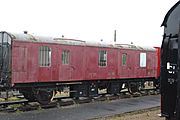 |
| BR | 96403 | 4-wheel Horse Box | Built in 1957. This box was used to carry horses for the Household Cavalry! It is now on display. |  |
Wagons and Cranes
The centre also has different types of wagons, including cranes.
Railway Cranes
| Original company | Number | Type | Status/Notes | Image |
|---|---|---|---|---|
| M&GCJR | 1 | 4-wheel Hand Crane | Built in 1914. It is currently being restored. | |
| LMS | No. ADM 27 | 10-ton hand-operated crane | Built in 1944. It was taken out of service in 1982. |


